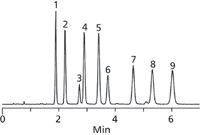Isolation and LC–MS Characterization of Illicit Bath Salts in Urine
In this article, the analysis of bath salts (phenethylamine and cathionone compounds) from urine samples is demonstrated using polymeric solid phase extraction (SPE) sample preparation followed by HILIC chromatographic analysis with TOF-MS detection. HILIC chromatographic conditions on the Ascentis? Express HILIC phase are used for fast, high-resolution separation of nine synthetic bath salts.
In this article, the analysis of bath salts (phenethylamine and cathionone compounds) from urine samples is demonstrated using polymeric solid phase extraction (SPE) sample preparation followed by HILIC chromatographic analysis with TOF-MS detection. HILIC chromatographic conditions on the Ascentis® Express HILIC phase are used for fast, high-resolution separation of nine synthetic bath salts. The polar basic nature of the bath salts makes these compounds prime subjects for HILIC chromatographic separation. These compounds are difficult to retain on traditional reversed-phase C18 and even polar embedded stationary phases. Under reversed-phase conditions, high aqueous conditions are necessary to achieve retention, often leading to decreased ionization and detection in ESI+ mass spec sources. High organic mobile phases are preferred for ESI+ MS detection due to faster analyte desolvation and more efficient analyte ionization. HILIC chromatographic conditions not only enable increased retention of such polar basic compounds, but the high organic conditions also translate to increased response in ESI+ mass spec detection. Figure 1 depicts the separation of all nine bath salts from a urine sample within 6 min on the Ascentis Express HILIC column.

Figure 1: Bath salt compounds in spiked urine sample after SPE cleanup, sample/matrix: 1 mL urine spiked to 100 ng/mL of bath salt mixture, SPE tube: Supelâ¢-Select SCX, 30 mg/1 mL (54240-U), conditioning: 1 mL 1% formic acid acetonitrile, then 1 mL water, sample addition: 1 mL spiked urine, washing: 1 mL water, 1 mL 1% formic acid in acetonitrile, 1 mL water, elution: 2 mL 10% ammonium hydroxide in acetonitrile, eluate post-treatment: thoroughly mix via vortex agitation, evaporate 1 mL aliquot to dryness, reconstitute in 100 µL water:methanol, column: Ascentis Express HILIC, 10 cm à 2.1 mm, 2.7 µm (53939-U), mobile phase: (A) 5 mM ammonium formate acetonitrile; (B) 5 mM ammonium formate water, flow rate: 0.6 mL/min, pressure: 127 bar, column temp: 35 °C, detector: MS, ESI+, 100-1000 m/z, injection: 1 µL, sample: 200 ng/mL in acetonitrile. Peaks: 1. MDPV, 2. Buphedrone, 3. 3-Fluoromethcathinone, 4. Butylone, 5. Ethylone, 6. 4-Fluoromethcathinone, 7. Mephedrone, 8. Methylone, 9. Methedrone.
Conclusion
The combination of the ion-exchange SPE with the HILIC separation provides a novel approach for the testing of difficult bath salt compounds. The isocratic Ascentis Express HILIC separation produces fast resolution of the isobaric compounds, thus, enabling the accurate quantitation of all nine bath salts. The Supel-Select SCX sample prep method allows for efficient urine matrix removal while maintaining high analyte recovery. By utilizing ion-exchange mechanisms for sample cleanup, and taking advantage of the unique selectivity of chromatographic modes such as HILIC, analytical chemists can greatly improve the selectivity and sensitivity of their difficult bioanalytical applications.
References
(1) M. Coppola and R. Mondola, "Synthetic cathinones: chemistry, pharmacology, and toxicology of a new class of designer drugs of abuse marketed as 'bath salts' or 'plant food,'" Toxicology Letters 211, 144–149 (2012).
(2) Federal Register Microgram Bulletin; U.S. Department of Justice Drug Enforcement Administration, Office of Forensic Sciences, 2011; Vol. 44.
Ascentis is a registered trademark of Sigma-Aldrich Co LLC. Supel is a trademark of Sigma-Aldrich Co LLC.
Supelco/Sigma-Aldrich
595 North Harrison Road, Bellefonte, PA 16823
tel. (800) 787-3526, (814) 359-3441
Website: sigma-aldrich.com/analytical

SEC-MALS of Antibody Therapeutics—A Robust Method for In-Depth Sample Characterization
June 1st 2022Monoclonal antibodies (mAbs) are effective therapeutics for cancers, auto-immune diseases, viral infections, and other diseases. Recent developments in antibody therapeutics aim to add more specific binding regions (bi- and multi-specificity) to increase their effectiveness and/or to downsize the molecule to the specific binding regions (for example, scFv or Fab fragment) to achieve better penetration of the tissue. As the molecule gets more complex, the possible high and low molecular weight (H/LMW) impurities become more complex, too. In order to accurately analyze the various species, more advanced detection than ultraviolet (UV) is required to characterize a mAb sample.

.png&w=3840&q=75)

.png&w=3840&q=75)



.png&w=3840&q=75)



.png&w=3840&q=75)













